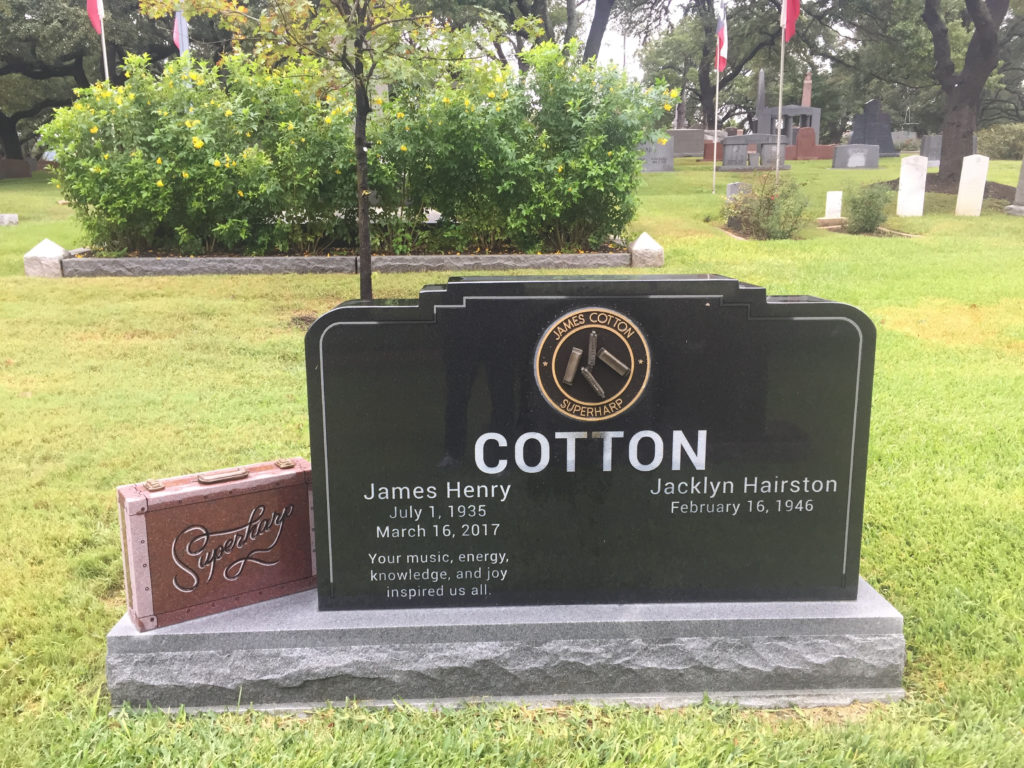Erik Visits an American Grave, Part 788
This is the grave of James Cotton.

Born in Tunica, Mississippi in 1935, Cotton was heavily influenced by the blues musicians a generation older than he in the Delta. He was a particular fan of Sonny Boy Williamson. As a boy, he and his uncle moved to West Helena, Arkansas, which happened to be where Williamson was. Later, Cotton said that he was an orphan and Williamson raised him, but it wasn’t true. It was however the kind of story that white blues fans loved, given their deep desire to mythologize these men when they became famous in white communities in the 1960s. He did however join Williamson’s band as the drummer and later led the band when Williamson moved to Wisconsin for a bit to try and reconcile with his wife.
By the time Cotton was 18, he was playing for Howlin’ Wolf and had switched from the drums to the harmonica. He was a great mouth harpist and made his name with it in the blues world. He started recording for Sam Phillips at Sun Records in 1953, when Phillips was still doing “race records” to use the parlance of the time, before he became famous recording white rock and roll. He also had a radio show on a station in Memphis, starting in 1952. But he had to work still and drove an ice truck. Making a living as a blues player was not easy.
Cotton played a bunch with Muddy Waters in these years as well. In 1965, he started his own band, the Jimmy Cotton Blues Quintet. Otis Spann was on piano and so it was a first rate band, though really a side gig for Cotton as he was getting paid to be part of Waters’ touring band. However, he rarely played on the Waters recordings of the period because for that, Muddy preferred his old friend Little Walter.
By 1966, Cotton was on his own full time and he did a good job tapping into the white craze for Black blues musicians of the time. He got a good opening gig for Janis Joplin, which exposed him to vastly more fans. His band came to include a big horn section. He worked with all sorts of white artists who came to love him–Gregg Allman, Paul Butterfield, the Grateful Dead, Keith Richards, Todd Rundgren, etc. Although I wouldn’t say Cotton got rich; after all, the blues craze did fade by the late 1970s, he remained relatively successful. Moreover, as the old blues legends began dying off, Cotton became that connection to the past for a lot of fans. His records began to gain more recognition in the 1980s. In 1996, he won a Grammy for his Deep in the Blues album. In 2006, he was inducted into the Blues Hall of Fame in Memphis. He played at the 2008 induction of Little Walter in the Rock and Roll Hall of Fame, along with Ben Harper.
Cotton’s health declined by the 1990s, including a bout with throat cancer. He still kept playing as long as he could, releasing albums up through 2013. He died in 2017 of pneumonia, at the age of 83.
Let’s listen to some James Cotton.
James Cotton is buried in Texas State Cemetery, Austin, Texas.
This is the last grave from my 2018 grave trip to central Texas. Thanks for all the LGM readers who helped make this happen! If you would like this series to visit more blues masters, you can donate to cover the required expenses here. Little Walter is in Chicago and Sonny Boy Williamson is in Tutwiler, Mississippi. Previous posts in this series are archived here.


